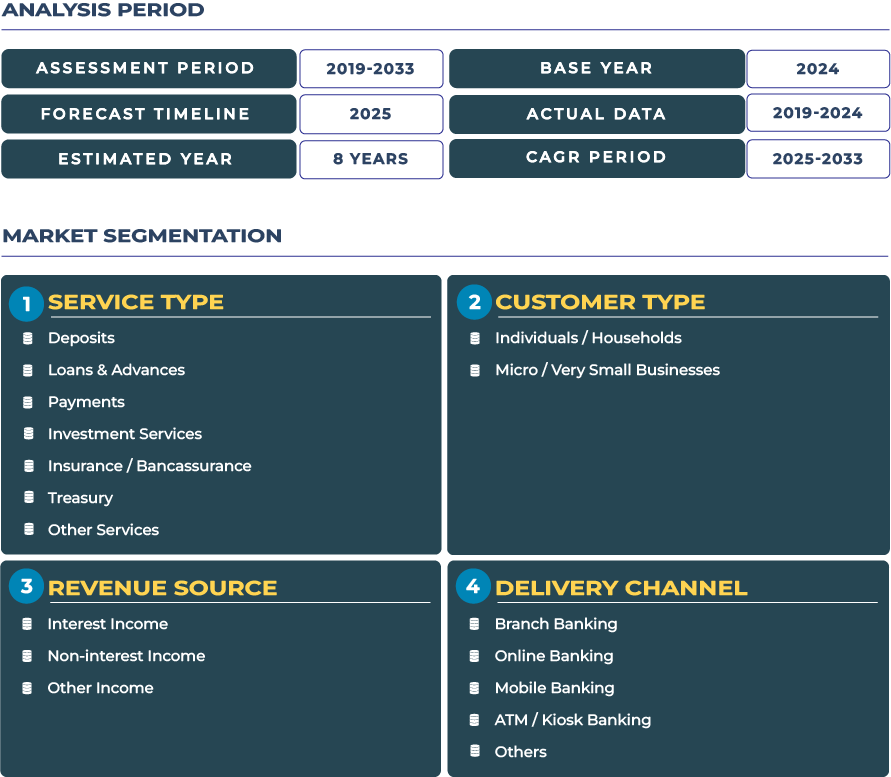US Retail Banking Market Outlook: Fintech-Driven Retail Banking Transformation Driving the Forefront of Change
The U.S. retail banking market is undergoing a structural transformation fueled by deep alliances between legacy banks and nimble fintech players. Fintech partnerships accelerate innovation pipelines and enable digital-first solutions across payments, lending, and advisory fronts. In this evolving U.S. retail banking ecosystem, conventional institutions are reshaping their strategies to embed digital wallets, real-time payments, and predictive services via APIs and orchestration layers.
Note:* The market size refers to the total revenue generated by banks through interest income, non-interest income, and other ancillary sources.
Against this backdrop, the U.S. retail banking market is projected to grow from USD 595.0 billion in 2025 to USD 708.9 billion by 2033, reflecting a CAGR of 2.2%. This growth underscores both the maturity of core services (deposits, credit) and the rising contribution of value-added services such as embedded insurance, investment advisory, and merchant finance. The competitive frontier in the U.S. retail banking landscape is no longer just deposit share-it is the ability to monetize digital engagement, cross-sell across service verticals, and retain customer wallet share.
However, this outlook must be viewed through the U.S. macro lens: interest rate normalization, consumer debt stress, and regulatory shifts (e.g. banking oversight, fintech regulation) will influence credit growth and operational costs. Economic headwinds such as slowing growth or geopolitical tensions may mute consumer borrowing or payment activity. Thus, the ability of U.S. retail banks to transform digitally, manage risk, and generate deeper wallet penetration will determine relative success in this competitive market.
Drivers & Restraints: Deep Forces Defining U.S. Retail Banking Trajectory
Driving Momentum from Fintech Alliances and Digital Consumer Expectations
A pivotal growth driver is the intensification of partnerships between banks and fintech firms, offering embedded lending, payment rails, and real-time analytics. Many U.S. banks are outsourcing or co-developing capabilities rather than rebuilding from scratch. This model accelerates innovation cycles, cuts time to market, and broadens product scope. Simultaneously, U.S. consumers-particularly the digital-native cohorts-demand intuitive mobile banking, frictionless payments, and instant credit. The high level of digital literacy accelerates adoption of advanced services like robo-advisory, micro-investing, and usage-based insurance. These conditions create a favorable confluence for growth in digital accounts, micro-loans, and fee-based services across the retail banking spectrum.
Restraining Pressures from Neobank Disruption and Regulatory Complexity
Yet the U.S. retail banking industry faces headwinds. Neobanks and digital-only challengers aggressively compete on pricing, user experience, and agility-with low overheads-that exert margin pressure. Many traditional banks must respond with sustained investment in modernization. Further, regulatory uncertainty looms: evolving scrutiny of bank-fintech partnerships, third-party risk frameworks, consumer protection rules, and data privacy laws demand compliance heavy lifting. Heightened oversight of third-party fintech providers means that banks bear more accountability and must impose stricter due diligence. As a result, regulatory complexity and capital burden can slow execution and elevate costs.
Trends & Opportunities: What’s Reshaping the U.S. Retail Banking Horizon
Trend: Instant Payments, Contactless Growth, and Mobile-First Banking
One defining trend is the proliferation of instant and contactless payments. The adoption of real-time payment systems and tokenization is redefining how consumers transact digitally. Digital wallets and integrated payment interfaces are becoming default for everyday spending. At the same time, mobile-first banking is becoming the central platform-not just a channel. Banks are embedding advice, alerts, credit lines, and financial insights within the mobile journey. Some are layering voice interfaces, biometric authentication, and contextual nudges to drive engagement.
Opportunity: Blockchain for Secure Settlement & Mobile Lending Platforms
An exciting opportunity lies in leveraging blockchain and distributed ledger technologies to streamline settlement, back-office reconciliation, and cross-border payments. While adoption is nascent, early pilots suggest cost and speed advantages. Another growth vector is mobile lending platforms powered by alternative data and real-time scoring-allowing near-instant approval of small consumer and merchant loans. Furthermore, bundling non-traditional services-such as point-of-sale financing, insurance, or subscription solutions-presents cross-sell upside. Retail banks that develop modular platforms and orchestrate services will capture greater share of customer lifetime value.
Competitive Landscape: Strategic Moves Among U.S. Retail Banking Leaders
Leading U.S. retail banks-such as JPMorgan Chase, Bank of America, Wells Fargo, Citibank, and Truist-are pursuing differentiated strategies. Many are strengthening cybersecurity posture across platforms, investing in zero-trust architectures, behavioral anomaly detection, and data governance systems. Others are exploring blockchain-enabled lending pilots for more efficient risk transfer and settlement. Some financial institutions have announced branch network rationalization coupled with advisory hubs embedded with technology. For instance, JPMorgan Chase continues to pivot capital into its digital consumer bank, while also maintaining select branch investments to support local relationships. In competitive response to fintechs, several banks are launching or acquiring digital lending arms, creating internal “innovation labs” or acquiring fintech startups. The outcome: scale will remain important, but the defining edge will rest on secure, agile, AI-infused customer experiences and cross-product monetization capabilities.







